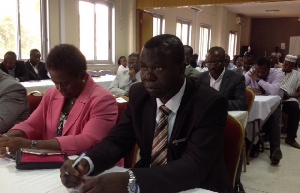The management of Komfo Anokye Teaching Hospital (KATH) in Kumasi has made a passionate appeal to the Ministry of Health (MOH) to provide a new and a bigger oxygen plant at the hospital to ensure effective delivery of health services to patients.
Chief Executive Officer (CEO) of KATH, Dr Joseph Akpaloo, said the hospital made similar appeal to the MOH last year but it seemed to have fallen on deaf ears, and as a result, KATH is currently relying on its obsolete plant for in-house production of oxygen which is operating below capacity, with its attendant challenges.
He bemoaned that the non-existence of a standard oxygen plant at KATH was also putting pressure on funds of the medical facility “as the hospital incurs huge sums of money in sourcing half of its oxygen needs from private companies which is a major drain on the hospital’s coffers.”
Speaking during the opening ceremony of the hospital’s 2015 mid-year performance review workshop, Dr Akpaloo once again appealed to the MOH “for a new and bigger oxygen plant at KATH as it has been done for our sister health institutions in the country.”
The KATH CEO was convinced that the provision of a standard oxygen plant at the hospital would go a long way to make it easier for KATH to provide emergency care and save lives.
The workshop which was attended by heads and some selected staff from all the various units of KATH provided a common platform for the hospital to take stock of its operations for the first half of the year and strategise to meet its set objectives for the remaining months of 2015.
Dr Akpaloo said the hospital managed to chalk some significant successes in the first half of 2015 as compared to last year, despite mountainous challenges which confronted the hospital, attributing the success story to the resilience and dedication of staffers of the hospital.
Highlighting some of the gains chalked at KATH during the period under review, he announced that specialist out-patients attendance recorded 125,670 cases as against 125,442 in 2014, which is a marginal increase of 0.18 percent, adding that physiotherapy services increased from 12,170 in 2014 to 12,337 in 2015.
Blood collection increased from 9,237 in 2014 to 10,175, representing an increase in 10.16 percent, emergency admissions increased from 11,841 in mid-year 2014 to 12,274 in mid-year 2015 and ward admissions increased from 18, 689 in mid-year 2014 to 20,329, this year.
He said there was a slight increase in the number of deliveries from 4,958 in mid-year 2014 to 5,103 in 2015, noting, “However, surgical operations dropped from 10,663 in mid-year 2014 to 8,488 in 2015 and diagnostic services also dropped from 183,780 in 2014 to 173,916 in 2015. Polyclinic OPD (Primary Care) dropped from 36,251 in mid-year 2014 to 34,637, same period in 2015, whilst family medicine also witnessed a drop from 8,561 in 2014 to 5,191, during the same period, this year.”
Dr Akpaloo mentioned that “the maternal death rate however, improved from 1119.25 per 100,000 live births in 2014 to 1077.80 live births in 2015, indicating that KATH’s infrastructural base also witnessed sharp development during the period under review.”
Health News of Thursday, 30 July 2015
Source: Daily Guide

















